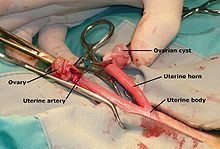
Back جراحة الحيوانات Arabic Chirurgie vétérinaire French 수의학 수술 Korean Veterinaire chirurgie Dutch Chirurgia weterynaryjna Polish Ветеринарная оперативная хирургия Russian Veteriner cerrahi Turkish Cérudjeye veterinaire WA


Veterinary surgery is surgery performed on non-human animals by veterinarians, whereby the procedures fall into three broad categories: orthopaedics (bones, joints, muscles), soft tissue surgery (skin, body cavities, cardiovascular system, GI/urogenital/respiratory tracts), and neurosurgery. Advanced surgical procedures such as joint replacement (total hip, knee and elbow replacement), fracture repair, stabilization of cranial cruciate ligament deficiency, oncologic (cancer) surgery, herniated disc treatment, complicated gastrointestinal or urogenital procedures, kidney transplant, skin grafts, complicated wound management, and minimally invasive procedures (arthroscopy, laparoscopy, thoracoscopy) are performed by veterinary surgeons (as registered in their jurisdiction). Most general practice veterinarians perform routine surgeries such as neuters and minor mass excisions; some also perform additional procedures.
The goal of veterinary surgery may be quite different in pets and in farm animals. In the former, the situation is more close to that with human beings, where the benefit to the patient is the important factor. In the latter, the economic benefit is more important.